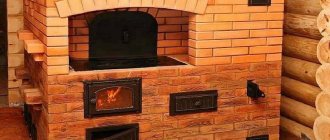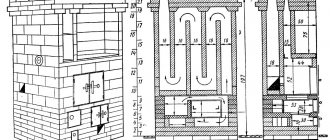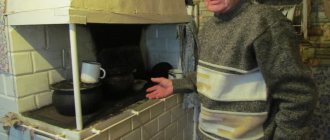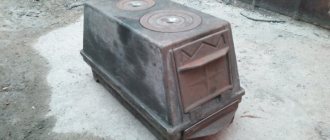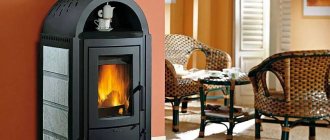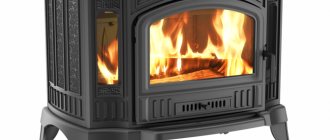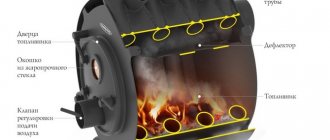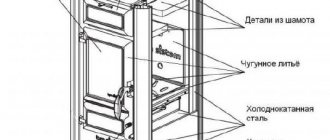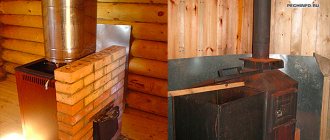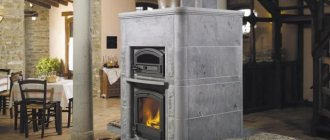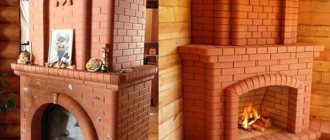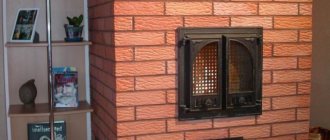In small country houses where there is no constant heating, a problem arises: how to quickly heat the room so that it becomes warm and cozy. To solve this problem, you can use wood-burning stoves for summer cottages, also called potbelly stoves.
In this article we have given a rating of the most popular models. When compiling it, we took into account their characteristics, price range, advantages and disadvantages according to users. We also outlined recommendations for choosing heating devices and rules for the safe operation of stoves.
Heating stoves for cottages and homes
Nowadays, stove heating seems to many city residents to be a “relic of the past.”
However, every owner of a country house or cottage who cares about his comfort knows that none of the modern methods of heating rooms can compare in efficiency with a heating wood stove - especially since modern devices of this type are not only highly efficient, but also safe and convenient to use. operation. The catalog of our online store contains heating stoves from the most famous brands. Any of the models that you can purchase from us can last for many decades.
Finishing
After the work with the brick is completed, you can inspect the brickwork again and open the seams additionally. Typically, DIY garden stoves are not plastered or lined with stone. If desired, this can be done if the design idea requires it or when a modern building is very different from the surrounding environment of the old dacha. Next to a small whitewashed house, a plastered stove decorated with paintings or tiles will look more harmonious. A stove in the depths of the garden, lined with natural stone, will look original, but if it stands on a lightweight foundation, this should not be done.
Main advantages and benefits
- High performance. The operating principle of heating stoves for summer cottages is extremely simple and, at the same time, very effective. In terms of their ability to heat large rooms, they are superior to radiator heating systems, IR heaters, and underfloor heating systems.
- Economical. Wood burning stoves do not require the use of expensive fuel
- Ecological cleanliness. The wood used to fuel such stoves is a 100% environmentally friendly product that does not emit toxins
- Special microclimate. The rooms where long-burning wood-burning stoves are used are always cozy
- Reliability . Due to their simple design, such devices rarely fail. If the stove breaks down, repairing it will cost much less and take much less time than fixing a malfunction of a radiator or infrared heating system
- Reasonable cost. After reviewing the prices of heating stoves presented in our catalog, you will be pleasantly surprised.
Cooking questions
In order to correctly make the stove you like, and before that, choose the right design, you need to know exactly what which outdoor stove can do. Therefore, before the technical and construction aspects, we will have to be distracted by culinary issues.
Oven or smokehouse?
An oven and a smokehouse are completely different devices. The furnace is required to “squeeze” as much heat as possible from the fuel load and not allow it to be wasted in space. Therefore, furnaces are designed (perhaps intuitively, based on the experience of generations) to burn fuel to the final combustion products - carbon dioxide and water vapor.
On the contrary, what is required from a smokehouse is not high thermal efficiency, but as much smoke as possible. But not just smoke that eats your eyes. Firstly, smoke for smoking should ideally not contain solid particles of unburned fuel. The final product should be smoked, not soot-encrusted. Anyone who has seen how a good industrial smokehouse works has probably noticed that in the area where the product is loaded, there is almost no visible smoke.
Secondly, smoke for smoking should not contain substances harmful to health. It is impossible to organize this chemically when burning organic fuel, so smokehouses are built in such a way that harmful impurities either “skip” past the smoked substance, or are neutralized and settle before it.
There is an important point here: in the temperature range of approx. It is extremely undesirable to smoke at 35-50 degrees, because... It is at such temperatures that there is a high probability of acid condensation; it is formed as a result of the interaction of chemically active particles of unburned fuel, the so-called. free radicals, water vapor and air oxygen. The acidified product not only tastes disgusting, but is also dangerous to health. Therefore, a trace is distinguished. types of smoking:
- Cold – the temperature in the smokehouse is up to 35 degrees. Preparation of products - salting in brine (saturated solution of table salt) and soaking immediately before loading into the smokehouse. Smoking time – from 5-6 days; breaks are not allowed. The taste of the finished product is the highest; shelf life without the use of means and methods of additional preservation can be calculated in months and years.
- Semi-hot (semi-cold) – smoking temperature 60-70 degrees. Preparation of products - short soaking in brine. The smoking period until ready is 0.5-2 days. Taste qualities are very high; the taste and bouquet are similar to those of cold smoked products. Keeping quality up to a month; usually up to 5 days.
- Hot – at a temperature of 85-120 degrees. Product preparation is not necessary. Smoking time – 1-5 hours. The taste qualities are very high, but the taste and aroma are not the same as those of cold smoked products. Shelf life without additional preservation up to 36 hours.
Considering the above, we can conclude that, firstly, the smokehouse for an outdoor stove must be a separate device. Any stove is not a smoke generator for smoking and it is impossible to set up the smoking process from the stove only by loading fuel and supplying air into the firebox; you also need to select the length of the flue from the outlet of the stove to the smoking chamber. Secondly, to feed a smokehouse with smoke, the simplest stove with low efficiency and a smoke tooth is best suited, see below.
Grill, grill and barbecue
An open flame is the enemy of any cooked food. Burning is only the visible and palpable “tip of the iceberg”: exposure to high temperatures on food products causes hydrolysis of fats, breakdown of carbohydrates and deep denaturation of proteins, saturating food with substances that are very harmful to health. In simple cooking ovens using solid fuel, direct contact of the food with the flame is avoided in various ways. What they have in common is that the food is not only baked, but also smoked, which is why, when properly prepared, its taste improves.
Grill
The hearth oven, which is commonly called a barbecue, is actually a classic Anglo-Saxon grill, the diagram of which is given on the left in Fig. Confusion arose in Canada, where French and English were mixed together. The grill structure follows from Anglo-Saxon culinary traditions, the essence of which was exaggeratedly but accurately expressed by Stubb from Melville’s novel “Moby Dick”: “You must take a piece of meat, from afar for a moment show it a slightly smoldering coal and immediately serve the steak to me!” Remember “bloody roast beef” from Eugene Onegin? In restaurants, baked meat is still offered rare - half-raw with blood, medium - baked until soft, juicy, like a kebab, and well done - crispy in a crispy crust.
Grill, barbecue and barbecue equipment
Note: if you find yourself in the southwestern United States, there may be something strange on the menu - hanaban (pronounced hanaban). This is a kebab in spices, removed from a skewer, something like Arabic khusal.
The grill is suitable for cooking rare, medium, and well done meat. This is achieved by placing the grate with the product at different levels above the brazier with coals. Coals rarely flare up, because... scattered in a thin layer over a dense floor and air access to them is limited. If they flare up, then the piece is simply moved to the side.
Brazier
Rare meat can be very tasty, but in southern countries, where pathogens of various diseases thrive, it can also be very dangerous. In addition, in many countries of the South they do not eat pork at all, and beef and lamb are rare and harsh. Hence the design of the barbecue (in the center in the figure): a holey under and partly the walls of a deep tray, a thick layer of coals. The meat is heated not only by thermal radiation, but also by a flow of hot air.
B-B-Q
In a real French barbecue (oh, those pampered paddling pools!), heat radiation is not involved at all in cooking. The design of a barbecue oven is quite complex (on the right in the figure), but reliable and multifunctional:
- Thanks to the separate cooking chamber with a hood, wind and outside temperature have almost no effect on the quality of the finished product.
- If you close the chamber portal with a flap lid, like in a Russian oven, the chamber turns into a semi-hot or hot smoked smokehouse.
- You can bake bread, cook pot roast, etc. in the oven. If salting the dish is undesirable, it is cooked in a container with a tight lid.
- Woodshed and dryer are relative concepts. Here and there you can dry mushrooms, berries, and fruits that require different drying modes. Additionally, it is regulated by dampers.
Note: pay attention to the protrusion of the hearth, which does not completely isolate the firebox from the oven. This is the so-called. a smoke tooth or jib is a radical means of reducing the dependence of the technical performance of any outdoor stove on weather conditions, see below.
Which model should you choose?
Before purchasing a heating wood stove for your home, there are several nuances to consider:
- The volume of the heated room . This is the main selection criterion. The figure declared by the manufacturer should be as close as possible to the actual volume of your room - strong deviations (in any direction) are undesirable
- Maximum power. The air temperature in the room is directly proportional to the power of the long-burning wood-burning stove installed in it, so this criterion is no less important when choosing heating equipment
- Size. Modern heating stoves for summer cottages come in both very large and miniature. In the vast majority of cases, the size of the device depends on its power
- Design. The appearance of the stove should be in harmony with the interior of the room. Heating stoves for the home are equipment that is purchased for a very long time, and therefore the design of the chosen model should please you and all members of your family
Installation
The process of installing a long-burning stove for heating a dacha is simpler than installing a radiator-type heating system. However, this work should also be entrusted to specialists. The slightest mistake when installing the device can result in serious problems during its operation.
Fortunately, the services of professional installers are not expensive at all. Our specialists will not only install a furnace to heat your home, but will also check its functionality and also clean up after themselves - you won’t need to do anything at all.
About the manufacturers
Our catalog presents wood heating stoves from the best manufacturers:
- TERMOFOR. This is the most famous Russian company engaged in the production of heating equipment. Each long-burning heating stove for a summer residence from this manufacturer is a truly reliable device, the performance of which fully corresponds to the declared indicators. In addition, TERMOFOR stoves have an excellent design
- Breneran (Buleryan). Equipment manufactured under this brand meets the highest international quality standards and can satisfy your most stringent requirements.
- Zharstal. Simple, inexpensive and high-performance furnaces from this manufacturer are becoming more and more popular every year
- STROPUVA. Ultra-modern and extremely reliable, these furnaces (boilers) are extremely easy to use and extremely efficient.
Do you want to know more about the products we offer? Or are you ready to buy a heating stove at a more than reasonable price? Call us!
Welcome to visit
After completing the construction of the stove, you can invite guests, but for this you need to arrange a recreation area around it. the area around the stove with tiles . If the dining table is not located in the gazebo, then it is worth considering what the patio will be like: laid out from the same tiles or made from decking boards. You can also make tables and benches yourself. Photos and detailed descriptions of the works can be found in large quantities on the Internet. The base columns for benches and tables can be made from leftover bricks, because after building a garden stove out of brick yourself, this will not cause much difficulty.
Folded strictly according to the design, in accordance with the order and using high-quality materials, the stove will serve faithfully for many years, gathering all your family and friends at your hospitable table. Many people make stoves in the garden with their own hands; there is no need to be afraid of difficulties.
Types of garden stoves
